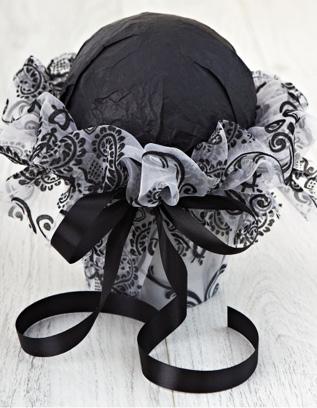The Contemporary Buttercream Bible (23 page)
Read The Contemporary Buttercream Bible Online
Authors: Christina Ong Valeri Valeriano

• Cake stand or covered cake board
Crumb coat then cover the cake with 200–300g
(7–101⁄2oz) of plain buttercream and blend using
100–200g (31⁄2–7oz) light blue green from the base
up (see Blending in Palette Knife Techniques).
Smooth the cake (see Smoothing in Buttercream
Basics). Colour 100–200g (31⁄2–7oz) buttercream
dark pink, 200–300g (7–101⁄2oz) dark green and
100–150g (31⁄ –51
2
⁄2oz) light green. Pipe the roses,
following the tutorial, using dark pink and
250–300g (9–101⁄2oz) plain buttercream for a
two-tone effect (see Up and Down Two-tone Ruffles
in Piping Textures and Patterns). Pipe a rose bud in
260
the same colours following the tutorial. Pipe stems
in dark green using the crochet technique (see
Crochet in Textile Effects). Add leaves in dark green (see Sunflower and Leaves) and tendrils in light
green.
261
Piping and Arranging
Flowers on a Cake
Now that you have learned how to pipe a whole
garden-full of buttercream flowers, you can become
a florist and arrange them on a cake. Here are four
techniques you can use in order to position them
securely and at the desired angle, to create just the look that you want. Anyone would be delighted to
receive a beautiful bouquet of flowers – even more
so if they are edible!
1
To securely attach a flower:
Pipe some roses in advance and use the freezing method described
in the Roses tutorial. Ideally, roses should be the
first flowers to be positioned on a cake. Decide
where you want them and using a piping bag with a
simple round nozzle (or just snip off the end of the
piping bag), continuously squeeze the bag to create
a blob. Peel off a rose from the greaseproof (wax)
paper and quickly rest it on the blob (A). A palette
knife and scissors can help you to tweak the
position. Hold the sides of the rose and slightly
262
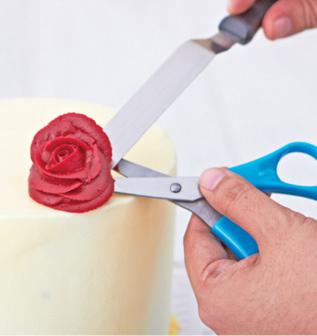
twist as you press down to make sure that it sticks
to the blob securely so it won’t fall off.
A
2
To position a flower at a desired angle:
Using a piping bag with a simple round nozzle (or
just snip off the end of the piping bag), pipe a blob big and wide enough to create a flat surface for the
flower to sit on. Make the blob high enough to raise
the flower up to the right height (B), and pipe your
flowers onto the raised blobs (C, D, E).
263
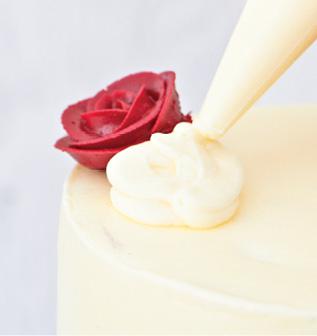
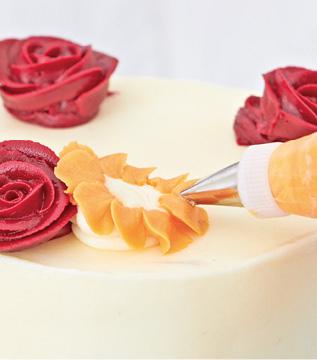
B
C
264
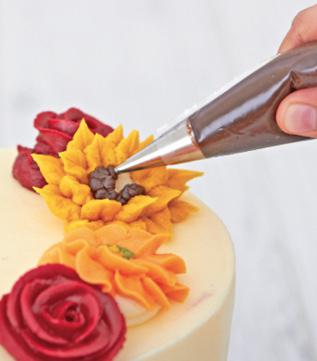
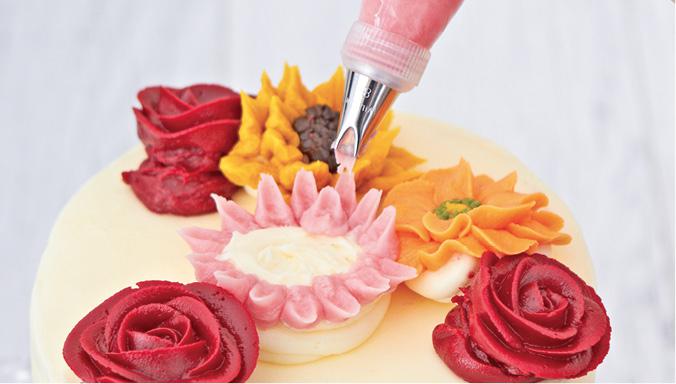
D
E
3
To pipe flowers on the side of the cake:
Make sure that you apply a little more pressure
when you are piping, so that you are sure that the
265
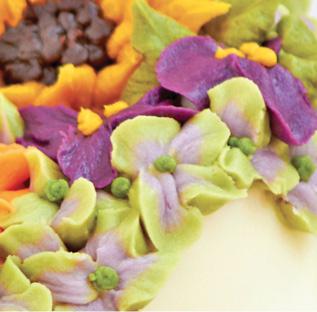
flowers stick to the cake. Avoid piping heavy flowers that use a lot of buttercream, such as carnations, on the side of a cake as they will sag or simply fall off.
4
To use flowers as fillers:
You can pipe small flowers like hydrangeas, sweet peas and violets as
well as leaves to cover up the blobs and to fill the
gaps between flowers (F). Don’t pipe all the leaves
in the same shade of green, but prepare several
different shades to make the results more realistic.
F
Tip
If positioning several flowers, pipe a guide
circle on the surface of the cake to ensure your
266
blobs, and therefore your flowers, are evenly
spaced. When decorating a cake with a
number of flowers on top you can simply
crumb coat the top of the cake and add the
flowers straight on top of that. There is no
need to give the top a second layer of smooth
buttercream as there is a tendency to use a lot
of buttercream in the piping of the flowers and
it can all become a bit too much!
267
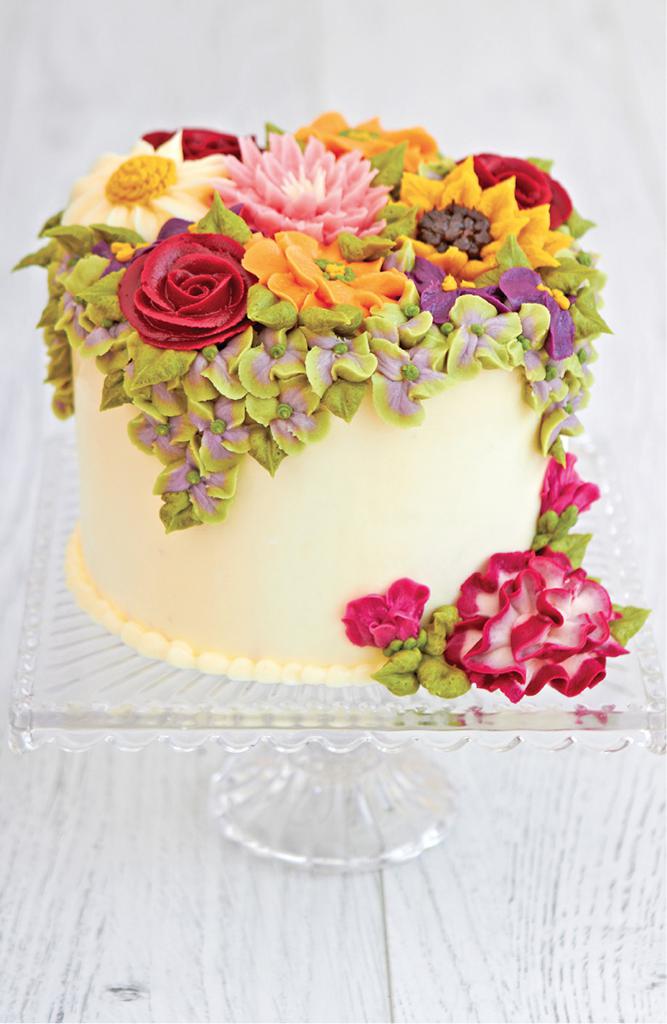
To create this cake…
• 15 × 10cm (6 × 4in) round cake
268
• 1.05–1.75kg (1lb 4oz–3lb 12oz) buttercream
• Paste colours: dark pink (Sugarflair Claret), light pink (Sugarflair Pink), red (Sugarflair Ruby Red),
orange (Sugarflair Tangerine), purple (Sugarflair
Grape Violet), green (Sugarflair Spruce Green or
Gooseberry) and brown (Sugarflair Dark Brown)
• Piping bags
• Cake stand or covered cake board
• Small petal nozzles (Wilton 104)
• Small leaf nozzles (Wilton 352)
• Scissors
Cover the cake using plain buttercream and giving
it a smooth finish (see Covering Cakes in
Buttercream Basics) and place on a stand or
covered board. Colour 150–250g (51⁄2–9oz) of
buttercream in each of the following colours: dark
pink, light pink, red, orange, purple, green and
brown. First pipe the roses, then the sunflower,
chrysanthemum, carnation, sweet pea and finally
the hydrangea and leaves according to the tutorials
in this chapter, and bearing in mind the advice on
arranging buttercream flowers on a cake. Complete
the cake by piping a border around the base (see
269
Shells and Fleur-de-lis in Piping Textures and
Patterns).
270
Cupcake Bouquet
A ‘cupcake bouquet’ is the way we describe a flower
arrangement
made
of
colour-coordinated,
divine-tasting cupcakes. It is the perfect picture of an edible work of art and makes a stunning
centrepiece or a lovely gift for any occasion. The key element used here is either a polystyrene
(Styrofoam) ball, or several plastic cups. The cup
method benefits from very easy to source materials,
but both yield lovely results. Be a little playful when choosing your decoration and use different
coloured papers and various accents.
Styrofoam-ball Method
1 Place the Styrofoam ball into a flower pot and
secure it with a glue or sticky tape. You may cover
your pot with pretty fabric or leave it plain. Tie
around some matching ribbons (A).
271
